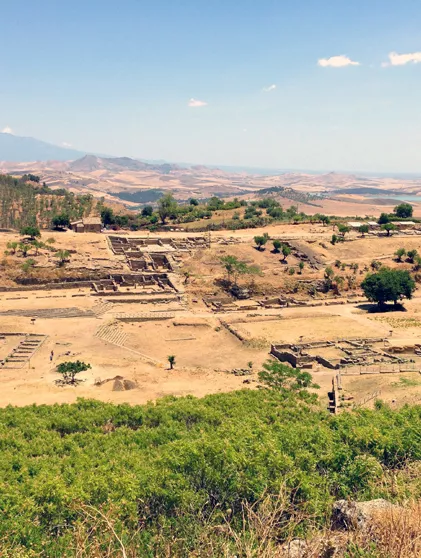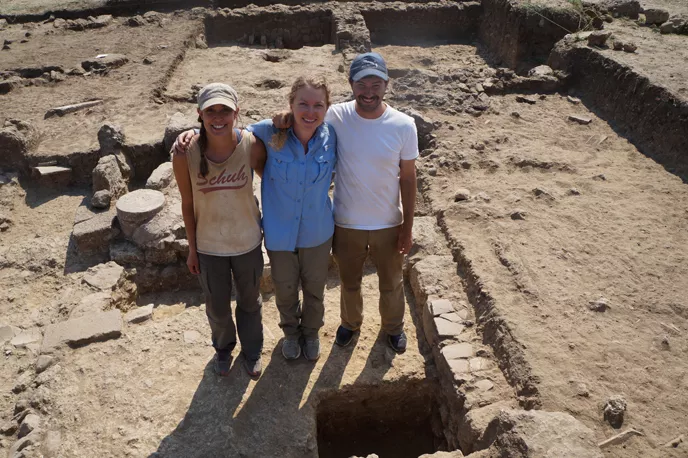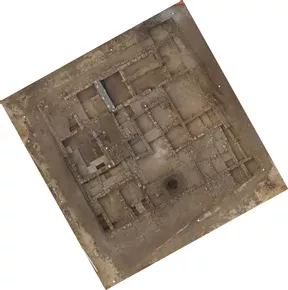
Every summer for the past three years, graduate students Andrew Tharler, Andrea Samz-Pustol, and Kiersten King have traveled to a remote town in central Sicily to excavate at the ancient Greek city of Morgantina. The settlement they explore was like many small towns in the ancient world. It could not compete with the monumental architecture of Agrigento and Selinunte to the west or rival the wealth of Syracuse to the east. But Morgantina remains one of the best surviving examples of a Greek city from this period, complete with an agora, theater, sanctuaries, houses, and even two bathing complexes.
Although rarely mentioned by ancient sources, the city has an unusually rebellious history. In the fifth century B.C.E. a local leader named Douketios led a revolt of the indigenous Sikel population against the Greeks and captured Morgantina’s archaic settlement. The city was subsequently refounded nearby, perhaps by Douketios himself. Morgantina thrived in the third century B.C.E. under the rule of Syracusan monarch Hieron II, whose death marks the beginning of the city’s contentious relationship with the conquering Romans. It revolted against Rome several times, formed an alliance with the Carthaginians during the Second Punic War, and slaughtered its Roman garrison. Rome finally punished the hostile city in 211 B.C.E., destroying many of its most important buildings and awarding it to a group of Spanish mercenaries. Morgantina experienced a measured revival over the next two centuries before undergoing another wave of destruction and abandonment. The coexistence of Sikel, Greek, and Roman populations at Morgantina have made it a rich source for the study of cross-cultural interactions and influences in the Classical world.
Together, Andrew, Andrea, and Kiersten work on the Contrada Agnese Project (CAP) directed by Professor Alex Walthall from the University of Texas. The current excavation explores a house in the remote western sector of the city, far from the public, administrative, and commercial buildings in the agora at the center. The agora and its vicinity were the focus of the first excavations of Morgantina conducted by Princeton University beginning in 1955. The houses uncovered during the first years of excavation clearly belonged to the city’s wealthiest residents. Many were laid out around columned peristyle courtyards and decorated with rich mosaics depicting scenes from Greek mythology. The Contrada Agnese Project aims to tell the stories of those living at the margins of Morgantina, far removed from the agora. The house currently being excavated has packed earth surfaces instead of mosaic floors, and may have been used for food preparation and industrial activities during a later phase.
Andrew, Andrea, and Kiersten each play an important role as members of the excavation team. Andrew has worked as a trench supervisor since 2015, overseeing the work of volunteer excavators from universities across the United States. During the season, he is responsible for directing the excavation of different areas of the trench, documenting each day’s activities and artifacts in a notebook, and photographing new layers for future publications. At the end of the season Andrew submits a final report interpreting how the trench fits into the broader narrative of the house.
As assistant supervisors, Andrea and Kiersten juggle their skillsets over a broad range of responsibilities. They are equipped with iPads to describe each layer excavated and quantify all the materials recovered in a database. When a notable artifact is discovered, they work with a total station to record the exact coordinates of its find spot. They are also charged with the laborious task of on-site photogrammetry, a process that requires them to shuffle deliberately along the margins of the trench, taking a new photograph with each step, sometimes from several different angles, until they have completed a full revolution around the area. Once stitched together by computer software, these overlapping photographs produce an interactive 3-D reconstruction of the trench that can be navigated as if walking around on site.
Working at Morgantina during the summer allows Andrew, Andrea, and Kiersten the opportunity to pursue their related academic interests. Andrea has done research on Sicilian sanctuaries, and for her dissertation plans on focusing on the Demeter cults in central Sicily. Kiersten’s interests lie in the cultural transformations that took place in Sicily as it transitioned from a Greek colonial frontier to a province in the Roman Empire. Her master’s thesis explored the development of the sacred spring of Arethusa in Syracuse from prehistory through the Roman period.
For Andrew, a dissertation topic lay in the vast amounts of material recovered by decades of excavation at Morgantina. In particular, he is researching Morgantina’s terracotta altars, small cylindrical objects that are often decorated with architectural motifs familiar from monumental Greek temples. Terracotta altars have been found at Morgantina since excavations began but were never fully published. Studying this material allows Andrew to pursue his interests in Greek religion, as he undertakes a contextual analysis of the altars to understand their significance in cult practice at Morgantina and in Hellenistic Sicily more broadly.
The three current graduate students working at Morgantina follow in a long tradition of Bryn Mawr’s involvement at the site. Professor Kyle M. Phillips took part in Princeton’s expedition during the 1960s to excavate a tomb in the Necropolis and conserve prehistoric pottery. While earning her Ph.D. at Bryn Mawr, Nancy Winter joined the excavation staff in 1970. Bryn Mawr Ph.D. Barbara Barletta studied monumental architecture from the site. Claire Lyons, the Curator of Antiquities at the Getty Museum and a Bryn Mawr Ph.D., authored the study on the early cemeteries at Morgantina. Another Bryn Mawr PhD, Sandra Lucore directed the excavations of the North Baths at Morgantina, the subject of her dissertation. In fact, Andrew’s first experience at Morgantina was working as a volunteer on Sandra’s project in 2010. The Contrada Agnese Project resumes excavation of the house this summer, as Andrew, Andrea, and Kiersten continue to strengthen Bryn Mawr’s historical bond with Morgantina.

